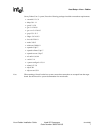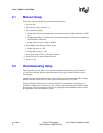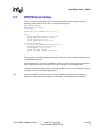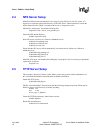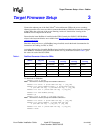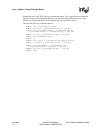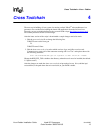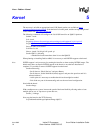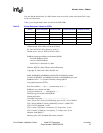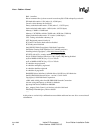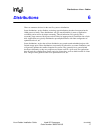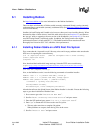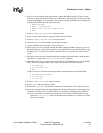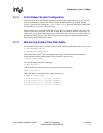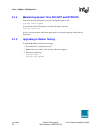
Distributions—Linux - Debian
Linux-Debian Installation Guide Intel
®
I/O Processors June 2005
Order Number: 306507001US 19
6. There is an issue with the dpkg program that is part of the Debian installer. It fails to create
lock files correctly when they are located on an NFS drive. The particular lock files are located
in /target/var/lib/dpkg, so we will address this issue by creating a RAM disk and mounting it as
/target/var/lib. Execute the following commands:
# mke2fs /dev/ram1
# mkdir -p /target/var/lib
# mount -t ext2 /dev/ram1 /target/var/lib
# exit
7. Scroll to “Configure the hostname” and press return.
8. Enter a name for this system or accept the default and press return.
9. Scroll to “
Install the Base System” and press return.
10. Select “
Network” to install the base system and press return.
11. Accept the default download URL or enter a new one.
12. When a proxy server is required, enter the IP address and port number of the proxy server in
the next dialog box. Note: Name resolution is not enabled at this step of the installation, so an
IP address (ex., 12.34.56.78) is required, a domain name (ex., proxy.domain.com) will NOT
work.
13. This takes some time since it downloads the base packages and installs them, when the base
installation is complete, the “
Installation Main Menu” reappears.
14. Before Rebooting, we must ensure that the files that are in the RAM disk are saved to the NFS
share. Scroll to “Execute a Shell”, press return, and enter the following commands:
# cd /target/var
# tar cvf lib.tar lib
# exit
On the Linux host, issue the following commands to untar the files from the RAM Disk.
# cd /exports/fs.xscale/var
# tar xvf lib.tar
# rm -f lib.tar
15. Scroll to “Reboot the system” and press return.
16. Select “
<Yes>” and press return to reboot.
17. Remove the”
/dev/ram1” line from the “/exports/fs.xscale/etc/fstab” file on the host system.
18. Since we are using kernel-level autoconfiguration, the networking scripts on the target do not
install the “/etc/resolv.conf” file which allows us to do name resolution properly. On the IA
Linux host, Create the “/exports/fs.xscale/etc/resolv.conf” file that looks like the following:
nameserver “
192.168.0.1”, make sure that the proper IP address of a nameserver on the
network is included.



